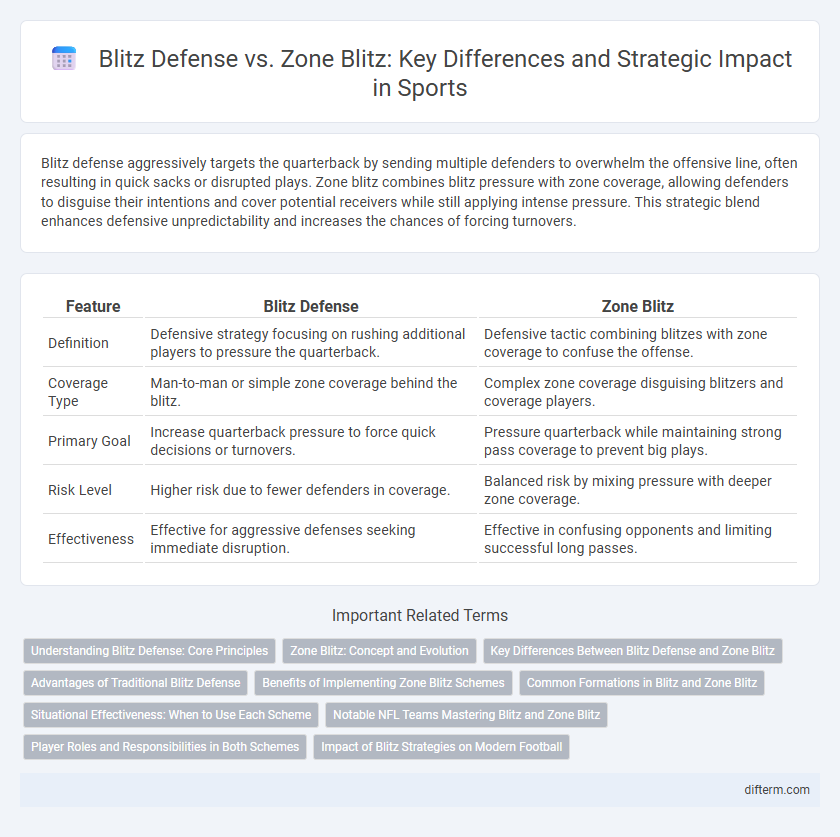Blitz defense aggressively targets the quarterback by sending multiple defenders to overwhelm the offensive line, often resulting in quick sacks or disrupted plays. Zone blitz combines blitz pressure with zone coverage, allowing defenders to disguise their intentions and cover potential receivers while still applying intense pressure. This strategic blend enhances defensive unpredictability and increases the chances of forcing turnovers.
Table of Comparison
| Feature | Blitz Defense | Zone Blitz |
|---|---|---|
| Definition | Defensive strategy focusing on rushing additional players to pressure the quarterback. | Defensive tactic combining blitzes with zone coverage to confuse the offense. |
| Coverage Type | Man-to-man or simple zone coverage behind the blitz. | Complex zone coverage disguising blitzers and coverage players. |
| Primary Goal | Increase quarterback pressure to force quick decisions or turnovers. | Pressure quarterback while maintaining strong pass coverage to prevent big plays. |
| Risk Level | Higher risk due to fewer defenders in coverage. | Balanced risk by mixing pressure with deeper zone coverage. |
| Effectiveness | Effective for aggressive defenses seeking immediate disruption. | Effective in confusing opponents and limiting successful long passes. |
Understanding Blitz Defense: Core Principles
Blitz defense focuses on overwhelming the offensive line by sending extra defenders to pressure the quarterback, aiming to disrupt plays quickly and force errors. Key principles include timing the blitz to exploit gaps, maintaining disciplined coverage, and balancing risk between aggressive pass rush and defensive backfield protection. Understanding these fundamentals allows teams to enhance defensive effectiveness while minimizing vulnerabilities against quick passes and run plays.
Zone Blitz: Concept and Evolution
Zone blitz is a strategic defensive scheme combining traditional zone coverage with unexpected blitzes to disrupt the quarterback's rhythm. It evolved from conventional blitzing by incorporating zone defenders to cover vacated areas, increasing defensive unpredictability and effectiveness. Modern NFL teams utilize zone blitzes to confuse offensive lines and create turnovers by exploiting offensive weaknesses in protection schemes.
Key Differences Between Blitz Defense and Zone Blitz
Blitz defense involves sending additional defenders to aggressively pressure the quarterback, focusing on overpowering the offensive line and disrupting plays quickly. Zone blitz combines traditional blitzes with zone coverage, where defenders drop into designated areas while others rush, creating confusion and increasing turnover chances. The key difference lies in personnel roles: blitz defense prioritizes overwhelming rushers, whereas zone blitz balances pass rush with strategic coverage to mask intentions.
Advantages of Traditional Blitz Defense
Traditional blitz defense offers the advantage of overwhelming the quarterback with direct pressure, often resulting in hurried throws or sacks. It allows defenders to disguise their intentions and exploit weaknesses in the offensive line, creating opportunities for turnovers. This aggressive approach limits the quarterback's decision-making time and disrupts the rhythm of passing plays effectively.
Benefits of Implementing Zone Blitz Schemes
Zone blitz schemes enhance defensive versatility by combining pass rush pressure with deep coverage zones, confusing quarterbacks and disrupting offensive timing. This strategy increases turnover opportunities by forcing hurried decisions, leading to interceptions and sacks. Implementing zone blitzes improves overall defensive effectiveness, especially against complex passing attacks and spread formations.
Common Formations in Blitz and Zone Blitz
Common formations in blitz defense often feature a 4-3 or 3-4 alignment, emphasizing aggressive linebacker and defensive back pressure to quickly disrupt offensive plays. Zone blitz formations commonly use a 3-4 base with selective linemen dropping into coverage while linebackers or defensive backs blitz, confusing the quarterback's read. Both blitz and zone blitz schemes rely on strategic positioning of defenders to maximize pressure and coverage effectiveness.
Situational Effectiveness: When to Use Each Scheme
Blitz defense excels in situations requiring immediate pressure on the quarterback, such as third-and-long or obvious passing downs, overwhelming offensive linemen and disrupting timing. Zone blitz offers strategic flexibility by dropping pass rushers into coverage while sending unexpected pressure from different angles, proving effective against quick reads and short passing games. Choosing between blitz and zone blitz depends on offensive tendencies, down-and-distance, and the defensive personnel's ability to disguise pressure and coverage effectively.
Notable NFL Teams Mastering Blitz and Zone Blitz
The Pittsburgh Steelers are renowned for their mastery of the zone blitz, leveraging complex patterns to confuse quarterbacks and generate frequent sacks. The Chicago Bears have historically excelled in traditional blitz defense schemes, employing aggressive stunts and pressure tactics to disrupt offensive plays. Teams like the Baltimore Ravens combine both blitz and zone blitz effectively, blending speed and coverage to create versatile defensive strategies that dominate in the NFL.
Player Roles and Responsibilities in Both Schemes
In blitz defense, linebackers and defensive backs aggressively target the quarterback, prioritizing rapid penetration and direct pressure to disrupt offensive plays. Zone blitz involves defensive linemen dropping into coverage while linebackers or defensive backs rush the passer, demanding versatile players capable of both coverage and blitz roles. Effective execution requires precise communication and adaptability as players switch responsibilities to confuse the offense and exploit coverage gaps.
Impact of Blitz Strategies on Modern Football
Blitz defense and zone blitz strategies significantly influence modern football by disrupting offensive timing and forcing quick decisions. Blitz defense relies on sending multiple defenders to pressure the quarterback, increasing the likelihood of sacks and hurried throws. Zone blitz, combining zone coverage with unexpected pass rushers, confuses offenses and creates turnover opportunities while maintaining defensive versatility.
blitz defense vs zone blitz Infographic

 difterm.com
difterm.com